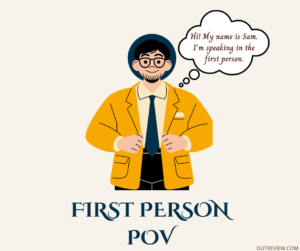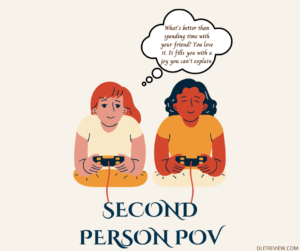Point Of View: What You Should Know
When you read anything, the first thing that registers with your subconscious mind is the author’s point of view. In general, works are divided into subjective and objective perspectives.
The literary device of point of view is used to indicate the angle or perspective from which a story is told. The “eyes” of the narrative voice that determine the position or angle of vision from which the story is relayed are referred to as point of view. For example, when you refer to a “bird’s eye view” of the compound, you’re referring to how the compound appears from the perspective of a bird hovering over it.
Point of view is one of the most important decisions made by fiction writers because it governs the reader’s access to the story and determines how much the reader can know at any given time about what is happening in the narrative.
Types of Points of View
As a literary device, point of view is generally expressed through the use of pronouns. In literature, there are three commonly used points of view, namely:
- First Person
- Third Person
- Second Person
Each has its advantages and limitations.
1. First Person POV

One of the story’s characters is narrating the literary work in first person. The use of first person pronouns, including “I,” indicates this point of view, and the reader assumes the character is close to the action of the story. The first person narrative voice gives the reader an intimate and close look into a character’s thoughts, but the story’s perspective is limited by what the character can see and know. Purple Hibiscus by Chimamanda Ngozi Adichie, narrated by a 16-year-old Kambili Achike, is a popular book that uses this POV.
Another version of the First Person POV is the First Person Peripheral POV.
-
First Person Peripheral POV
There is one significant difference between this and the standard first person POV. With the first person peripheral POV, the story is told to readers by a narrator who is not the main character. When a story is written in the first person peripheral POV, the narrator, not the protagonist, is referred to as “I” or “me.” When the terms “we” or “us” are used, they refer to the narrator and one or more people, who may or may not include the main character. The Book Thief by Markus Zusak is an example of a work written in the first person peripheral POV.
READ ALSO: The Book Thief by Markus Zusak | Book Review
2. Third Person POV

There is a narrative presence telling the story and referring to the characters in the third person as “he” or “she” in third person point of view. Third person point of view can be omniscient, limited, or limited omniscient.
-
Omniscient
An omniscient narrator sees everything, much like an all-knowing god. He or she can see what each character is doing and read their minds. This is common with an external character who stands above the action and observes it.
-
Limited:
The narrator sees only what is directly in front of him/her. They become a bystander to events and are unable to read the minds of other characters.
-
Limited Omniscient:
A limited omniscient third-person narrator can only see into the mind of one character. They may witness other events, but they are only aware of the reasons for one character’s actions in the story. This is the most common option for writers who want to avoid using the first person point of view.
3. Second Person POV

The pronoun “you” is used in second person point of view to address the reader and draw them into the action of the story. However, using the second person is problematic in a couple of ways. For starters, it is an unusual stylistic choice, particularly in novel-length works. Furthermore, using the second person can overwhelm the writer while also confusing and/or alienating the reader. Most writers avoid developing a narrative voice in the second person. The Reluctant Fundamentalist by Mohsin Hamid is an example of a work written in the second person.
Writing with Point of View: Which Should You Use?
In literature, first and third person perspectives are far more common than second person perspectives. By giving the reader access to the narrator’s inner thoughts, the writer can establish intimacy with the reader. Third person narrative is versatile in that the writer can concentrate on the actions and thoughts of multiple characters.
One of the most difficult aspects of beginning a story as a writer is deciding who will tell it. When deciding on a point of view, you must consider both the advantages and disadvantages, as this is critical for character development and the relationship between the narrative voice and the reader.
READ ALSO: The Perks of being a 21st-century Writer
How to Choose the Right Point of View
-
Trying different points of view:
The only way to determine the best point of view strategy for your novel is to experiment with various options. You’ll probably know which one is right for your story because the writing will start to move faster and you’ll feel momentum.
-
Establish it:
Once you’ve decided on a stance, stick to it. Whatever narration style you use, it’s critical to quickly establish your point of view. Always tell the reader which character’s point of view you’re taking in any given scene.
-
Be aware of limitations:
Character development relies heavily on point of view. You must be aware of your characters’ limitations at all times. Examine your writing frequently to look for errors such as giving characters information or opinions they would not normally have.
Should You Alternate Between Points of View?
It is critical that you establish your point of view as soon as possible for the reader so that they know whose perspective they are following. Though some writers choose to switch points of view, which is most common in novels, the narrative voice should remain consistent throughout a scene.
Changing the narrative perspective in the middle of a story can be confusing and jarring for the reader. Changing the point of view of a literary work for a subplot, alternate section, or different chapter can be beneficial; however, there should be narrative continuity throughout the course of a story’s scene in consideration of the reader.
A complex type of observation or narration is alternating point of view. While narrating, you can switch from first person to third person or even second person. It is determined by the setting, situation, and voice of the characters, as well as their various points of view. Kurt Vonnegut used this technique very successfully in Slaughterhouse-Five. In addition, alternating points of view are used for long narration or chapter-wise development of characters and story. It isn’t used for a single sentence or paragraph.
The Importance of Point of View
A story’s point of view is important because it helps the reader understand the characters’ feelings and actions. Each character will have their own point of view, so whoever is telling the story will influence the reader’s perception of other characters and events.
-
Creating suspense:
When a reader is more knowledgeable than the character, as in Bram Stoker’s Dracula, and your reader waits for the character to learn what they already know. Your reader will be on the edge of their seat as a result of this tension.
-
Creating an unreliable narrator:
When a first-person narrator knows more than the reader but intentionally withholds information from them in order to manipulate them. Gillian Flynn‘s Gone Girl is an excellent example of an unreliable narrator.
-
Creating comedic irony:
When a first-person narrator knows so little as compared to both the reader and the other characters that it creates comedy. The reader is laughing at the narrator rather than with him or her in this strategy.
-
Creating tragic irony:
When the characters are less knowledgeable than the reader. Foreshadowing is another form of narrative irony in which the omniscient narrator leaves hints for the reader about something that will happen in the future. A sense of irony is created when a tragic event is foreshadowed but the characters do not see it coming.
Furthermore, reading the story from the perspective of a character in the story rather than an external character alters the amount of information a reader has as the story unfolds. With an omniscient third-person perspective, we can see everything before other characters, giving us forewarning about future events. We are not allowed to see other events in a limited third-person narrative until the narrator does so. This could lead to more surprises as we read.
Final Words
The importance of point of view in all writing cannot be overstated. It adds interest to stories, lends a serious tone to research, lends a personal tone to poems and persuasive works, and allows readers to easily follow all writing. Keeping in mind the various types of POV and when to use them will help you write better.

